- View more resources from this publisher
 Core Maths
Core Maths
The Princess's Problem
In this resource students deal with an optimisation problem involving perimeter and area based on a Greek mythological story about a princess. She wants to maximise the area contained in a given perimeter and decides on a circle. The concept of the Isoperimetric Quotient Number, IQN, is introduced as a way of confirming the intuitive solution to the problem.
The Princess's Problem Overview outlines the scope of the resource, any prior knowledge required, suggested approaches and possible extensions.
The Princess's Problem Guidance puts the problem into context. There are clearer suggestions about how the problem could be introduced and how it could fit into a teaching scheme. In particular it suggests that students could be asked to investigate particular types of shapes e.g. rectangles and squares when they should find that IQN ≤ π/4. It also suggests that access to spreadsheets could be useful.
The Princess's Problem Handout presents the optimisation problem and asks students to consider the Isoperimetric Quotient Number (IQN) for a circle, square, rectangles and an equilateral triangle before proceeding to consider regular polygons.
Show health and safety information
Please be aware that resources have been published on the website in the form that they were originally supplied. This means that procedures reflect general practice and standards applicable at the time resources were produced and cannot be assumed to be acceptable today. Website users are fully responsible for ensuring that any activity, including practical work, which they carry out is in accordance with current regulations related to health and safety and that an appropriate risk assessment has been carried out.
Downloads
-
The princess's problem (overview) 210.86 KB
-
The princess's problem (handout) 232.99 KB




